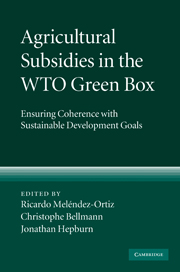Book contents
- Frontmatter
- Contents
- List of contributors
- Preface
- Acknowledgements
- List of abbreviations
- 1 Overview
- PART I The recent evolution of agricultural trade policy reform
- PART II The focus, extent and economic impact of green box subsidies
- PART III Green box subsidies and developing countries
- 11 Agricultural subsidies in the WTO green box: opportunities and challenges for developing countries
- 12 Use of green box measures by developing countries: an assessment
- 13 A Chinese perspective on the green box
- 14 African countries and the green box
- PART IV Green box subsidies and the environment
- PART V Looking forward: how can change take place?
- Appendix: Text of Annex 2 of the WTO Agreement on Agriculture (“the green box”)
- Index
- References
11 - Agricultural subsidies in the WTO green box: opportunities and challenges for developing countries
from PART III - Green box subsidies and developing countries
Published online by Cambridge University Press: 03 May 2010
- Frontmatter
- Contents
- List of contributors
- Preface
- Acknowledgements
- List of abbreviations
- 1 Overview
- PART I The recent evolution of agricultural trade policy reform
- PART II The focus, extent and economic impact of green box subsidies
- PART III Green box subsidies and developing countries
- 11 Agricultural subsidies in the WTO green box: opportunities and challenges for developing countries
- 12 Use of green box measures by developing countries: an assessment
- 13 A Chinese perspective on the green box
- 14 African countries and the green box
- PART IV Green box subsidies and the environment
- PART V Looking forward: how can change take place?
- Appendix: Text of Annex 2 of the WTO Agreement on Agriculture (“the green box”)
- Index
- References
Summary
11 years of green box usage
Perhaps because green box subsidies are not subject to commitments in the AoA, relatively few studies have analysed expenditure in this area. It is therefore not easy to find studies compiling notified expenditure and comparing situations among green box users. Although the WTO (2000) Secretariat background paper is one exception, this study has not subsequently been updated.
Moreover, the green box comprises different programme types and is divided into several categories, making it even harder to offer comparisons between them. Some existing analyses of green box categories focus on decoupled income support and direct payments to producers. The work of the Organization for Economic Cooperation and Development (OECD) is particularly worthy of mention in this respect.
This section is based on a compilation of green box notifications for a selected number of developed and developing countries. The first part briefly introduces subsidy disciplines in the AoA and looks at traditional green box policies. The subsequent sections are supported by notifications from 1995 onwards.
Typical green box policies: legal arguments and interpretations
The AoA, established in the Uruguay Round, brought disciplines for the use of agricultural subsidies (domestic support and export subsidies) into the multilateral trading system for the first time, establishing limitations and reduction commitments. The agricultural subsidies were classified into three categories:
Amber box: domestic support measures that can cause distortion and for this reason are subject to reduction commitments based on the total aggregate measurement of support (AMS). The concept of de minimis must also be mentioned here: this represents a minimum subsidy allowance, which is 5 per cent of the value of production for developed countries and 10 per cent for developing countries.
[…]
- Type
- Chapter
- Information
- Agricultural Subsidies in the WTO Green BoxEnsuring Coherence with Sustainable Development Goals, pp. 329 - 368Publisher: Cambridge University PressPrint publication year: 2009
References
- 1
- Cited by



